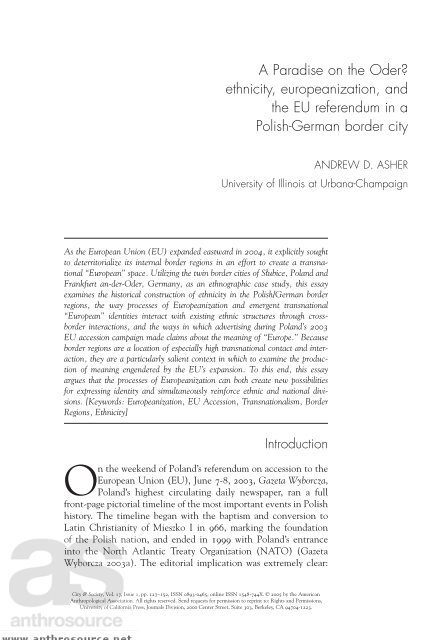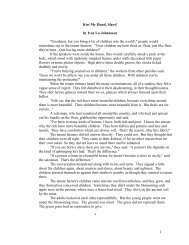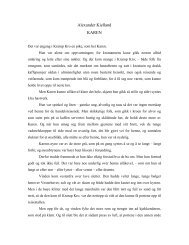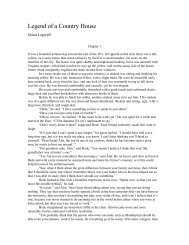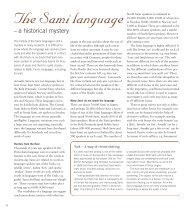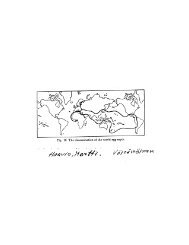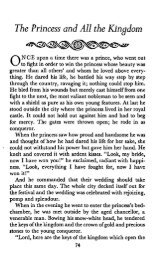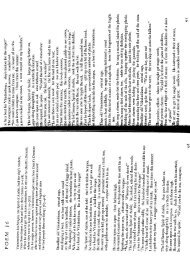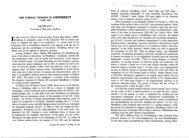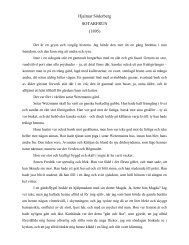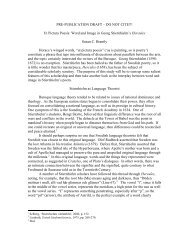A Paradise on the Oder? - Department of Scandinavian Studies
A Paradise on the Oder? - Department of Scandinavian Studies
A Paradise on the Oder? - Department of Scandinavian Studies
You also want an ePaper? Increase the reach of your titles
YUMPU automatically turns print PDFs into web optimized ePapers that Google loves.
<str<strong>on</strong>g>Paradise</str<strong>on</strong>g> <strong>on</strong> <strong>the</strong><strong>Oder</strong>?de-emphasize by promoting an overarching “European” identitythat can encompass multiple ethnicities.A European border?Due to <strong>the</strong> high level <strong>of</strong> cross-border c<strong>on</strong>tact and interacti<strong>on</strong>,<strong>the</strong> Polish/German border regi<strong>on</strong>s are also locati<strong>on</strong>swhere <strong>the</strong> EU has most vigorously pursued policies aimedat de-emphasizing and Europeanizing nati<strong>on</strong>al boundaries. “Bridge”towns such as Słubice/Frankfurt(<strong>Oder</strong>) are <strong>of</strong>ten described aslaboratories <strong>of</strong> European integrati<strong>on</strong>, a positi<strong>on</strong> that makes <strong>the</strong>mextremely important symbols for <strong>the</strong> project <strong>of</strong> EU expansi<strong>on</strong>. Thesame symbolism is invoked <strong>on</strong> <strong>the</strong> Euro paper currency, which featuresevolving architectural styles <strong>of</strong> bridges <strong>on</strong> each successivelyhigher denominati<strong>on</strong>.The processes <strong>of</strong> deterritorializati<strong>on</strong> in <strong>the</strong> Polish/German borderregi<strong>on</strong>s are characterized by an increased emphasis <strong>on</strong> regi<strong>on</strong>alinitiatives with <strong>the</strong> ultimate goal <strong>of</strong> creating what Martinez (1994)calls “integrated borderlands,” or border regi<strong>on</strong>s that have “no barriersto <strong>the</strong> flow <strong>of</strong> goods and people,” and “enjoy a relati<strong>on</strong>ship <strong>of</strong>equality, trust and respect” (D<strong>on</strong>nan & Wils<strong>on</strong> 1999:51). To thisend, <strong>the</strong> EU has created cross-border “Euroregi<strong>on</strong>s” to help facilitatecultural and ec<strong>on</strong>omic cooperati<strong>on</strong> and integrati<strong>on</strong> between itsmember states, and has provided various regi<strong>on</strong>al funding initiativesaimed specifically at transnati<strong>on</strong>al and interregi<strong>on</strong>al cooperati<strong>on</strong>. 5In Słubice/Frankfurt(<strong>Oder</strong>), <strong>the</strong>se initiatives have funded culturalevents, educati<strong>on</strong>al activities, infrastructure development, and ec<strong>on</strong>omicinvestment, all <strong>of</strong> which endeavor to promote c<strong>on</strong>tact andinteracti<strong>on</strong> between and am<strong>on</strong>g Polish and German citizens livingin <strong>the</strong> border regi<strong>on</strong>s.Crossing over <strong>the</strong> bridge between Poland and Germany andthrough its passport and customs checkpoint is a regular (andsometimes daily) experience for many <strong>of</strong> Słubice/Frankfurt(<strong>Oder</strong>)’sresidents, who are c<strong>on</strong>scious <strong>of</strong> crossing between two separatelyc<strong>on</strong>structed spaces. As <strong>on</strong>e <strong>of</strong> <strong>the</strong> dominant architectural features<strong>of</strong> <strong>the</strong> cities, <strong>the</strong> bridge (Fig. 1) itself is symbolic <strong>of</strong> both Europeanc<strong>on</strong>necti<strong>on</strong> and nati<strong>on</strong>al separati<strong>on</strong>, and <strong>on</strong>e <strong>of</strong> <strong>the</strong> first sights togreet an eastward traveler is a white and red border marker bearinga crowned white eagle, <strong>the</strong> nati<strong>on</strong>al symbol <strong>of</strong> Poland. A localuniversity student remarked to me that <strong>the</strong>re should be an <strong>of</strong>ficialmarker at <strong>the</strong> center <strong>of</strong> <strong>the</strong> bridge that indicates where <strong>on</strong>e crosses“into <strong>the</strong> East,” a statement that acknowledges <strong>the</strong> deep histori-131
City & Societycal and cultural divisi<strong>on</strong>s that are <strong>of</strong>ten also encompassed by <strong>the</strong>Polish-German border (cf. Wolff 1994).Despite <strong>the</strong> cities’ proximity to <strong>on</strong>e ano<strong>the</strong>r (about a 5 minutewalk and usually no more than 5 minutes in <strong>the</strong> customs queue), <strong>the</strong>border remains a distinct marker <strong>of</strong> difference, and <strong>the</strong> difficulty <strong>of</strong>suddenly encounteringand negotiatinga foreign culture isregarded by many asat least a minor hardship.Fur<strong>the</strong>rmore,when an individualcrosses through <strong>the</strong>border checkpoint,he or she must formallydem<strong>on</strong>strate anati<strong>on</strong>al citizenshipby twice presentinga nati<strong>on</strong>al IDcard or passport forFig. 1. The bridge between Słubice (L) and Frankfurt(<strong>Oder</strong>) (R). [Photo by author] verificati<strong>on</strong> to both<strong>the</strong> German and <strong>the</strong>Polish authorities 6 . Due to <strong>the</strong> close associati<strong>on</strong> <strong>of</strong> ethnicity withboth <strong>the</strong> cultural and legal definiti<strong>on</strong>s <strong>of</strong> citizenship in Poland andGermany 7 individuals living <strong>on</strong> both sides <strong>of</strong> <strong>the</strong> border routinelycombine <strong>the</strong> c<strong>on</strong>cepts <strong>of</strong> ethnicity and citizenship into <strong>the</strong> generalcategories <strong>of</strong> “Poles” and “Germans,” as a heuristic shorthand withwhich to make comparative generalizati<strong>on</strong>s about perceived similarityand difference.By advocating a transnati<strong>on</strong>al c<strong>on</strong>cepti<strong>on</strong> <strong>of</strong> identity andcitizenship, <strong>the</strong> EU endeavors to eliminate <strong>the</strong> transformativefuncti<strong>on</strong> <strong>of</strong> borders as <strong>the</strong> point where an individual moves fromidentificati<strong>on</strong> with an ethnic majority to an ethnic minority orfrom <strong>the</strong> positi<strong>on</strong> <strong>of</strong> a citizen to that <strong>of</strong> a foreigner (cf. Berdahl1999:4). Never<strong>the</strong>less, despite <strong>the</strong> fact that Polish and Germancitizens have been able to circulate freely across <strong>the</strong> border inSłubice/Frankfurt(<strong>Oder</strong>) since 1991, <strong>the</strong> border still corresp<strong>on</strong>dswith a str<strong>on</strong>g ethnic and cultural distincti<strong>on</strong>s. Therefore, whilemany <strong>of</strong> my resp<strong>on</strong>dents c<strong>on</strong>sidered <strong>the</strong>mselves to be residents <strong>of</strong><strong>the</strong> locally transnati<strong>on</strong>al urban space <strong>of</strong> Słubice/Frankfurt(<strong>Oder</strong>),most would also admit to feeling more comfortable or more “athome” <strong>on</strong> <strong>on</strong>e side <strong>of</strong> <strong>the</strong> border.132
<str<strong>on</strong>g>Paradise</str<strong>on</strong>g> <strong>on</strong> <strong>the</strong><strong>Oder</strong>?Transnati<strong>on</strong>al C<strong>on</strong>sumpti<strong>on</strong>As a cultural, ethnic and political fr<strong>on</strong>tier, <strong>the</strong> Polish/Germanborder forms what Gupta and Fergus<strong>on</strong> characterize as an“interstitial z<strong>on</strong>e <strong>of</strong> displacement and deterritorializati<strong>on</strong>that shapes <strong>the</strong> identity <strong>of</strong> <strong>the</strong> hybridized subject” (1992:18). Byemphasizing policies <strong>of</strong> deteritorializati<strong>on</strong> at its internal borders,<strong>the</strong> EU produces a c<strong>on</strong>text where <strong>the</strong> potential meanings <strong>of</strong> anemergent transnati<strong>on</strong>al and European identity are negotiatedthrough comm<strong>on</strong>place cross-border cultural interacti<strong>on</strong>s. Słubice/Frankfurt(<strong>Oder</strong>) should <strong>the</strong>refore be understood as a culturally creativespace where “where [multiple subjectivities] coexist . . . eachwith its own gravity and density” (Rosaldo 1989:163), and wheremultiple ethnicities and identities meet and interact to create newsocial meanings.Given <strong>the</strong> EU’s emphasis <strong>on</strong> policies that promote an unrestrictedmarket, it is perhaps not surprising that in Słubice/Frankfurt(<strong>Oder</strong>) shopping and <strong>the</strong> c<strong>on</strong>sumpti<strong>on</strong> <strong>of</strong> goods andservices are two <strong>of</strong> <strong>the</strong> foremost reas<strong>on</strong>s for crossing <strong>the</strong> border inei<strong>the</strong>r directi<strong>on</strong>. Shopping is a fundamental border activity (cf.D<strong>on</strong>nan and Wils<strong>on</strong> 1999, Thuen 1998, Wils<strong>on</strong> 1993, 1995), andaccording to a study by Schultz, it is by far <strong>the</strong> primary reas<strong>on</strong> forcross-border trips by residents <strong>of</strong> border cities throughout Europe,but especially in Eastern Europe (2002:26). For many individualsliving in Frankfurt(<strong>Oder</strong>)/Słubice, shopping is <strong>of</strong>ten <strong>the</strong> way <strong>the</strong>yexperience <strong>the</strong> border, and as Berdahl (1999) describes in her ethnography<strong>of</strong> <strong>the</strong> border between East and West Germany, <strong>the</strong> circulati<strong>on</strong><strong>of</strong> people and objects intrinsic to shopping and c<strong>on</strong>sumingacross a border provide important c<strong>on</strong>texts for ascribing difference.Because <strong>the</strong> border between Frankfurt(<strong>Oder</strong>) and Słubice is also<strong>of</strong>ten perceived as an ethnic boundary, <strong>the</strong> distincti<strong>on</strong>s and socialrelati<strong>on</strong>s dem<strong>on</strong>strated through shopping frequently acquire ethnicdimensi<strong>on</strong>s, while <strong>the</strong> commodities procured during this “ritualpractice” are “used to c<strong>on</strong>stitute <strong>the</strong> complexity <strong>of</strong> c<strong>on</strong>temporarysocial relati<strong>on</strong>s” (Miller 1998:8).During my interviews and c<strong>on</strong>versati<strong>on</strong>s in Słubice/Frankfurt(<strong>Oder</strong>), shopping was a subject <strong>of</strong> tremendous discussi<strong>on</strong>,especially with regard to relative prices and <strong>the</strong> best places to buyparticular items. Some items are dem<strong>on</strong>strably cheaper or easierto obtain <strong>on</strong> <strong>on</strong>e side <strong>of</strong> <strong>the</strong> border. For example, gasoline is about20% cheaper <strong>on</strong> <strong>the</strong> Polish side, leading to l<strong>on</strong>g queues <strong>of</strong> automobilesat <strong>the</strong> border, especially <strong>on</strong> weekends and holidays. Cigarettesare also cheaper <strong>on</strong> <strong>the</strong> Polish side, as are many grocery items, such133
City & Societyas produce—most notably strawberries and asparagus—and bakedgoods. Cosmetics are <strong>of</strong>ten cheaper <strong>on</strong> <strong>the</strong> German side, while serviceproducts such as dentists, hair and beauty sal<strong>on</strong>s, restaurants,and “nightclubs” featuring dancers and <strong>of</strong>ten prostituti<strong>on</strong>, arealmost always cheaper and are in greater abundance <strong>on</strong> <strong>the</strong> Polishside. The daily exchange rate fur<strong>the</strong>r influences purchasing choices,and <strong>the</strong> carrying <strong>of</strong> two currencies is comm<strong>on</strong>place and <strong>of</strong>ten anecessity, leading to a prevalence <strong>of</strong> currency exchanges (kantor),especially <strong>on</strong> <strong>the</strong> Polish side. Because Poland is not projected toadopt <strong>the</strong> Euro until at least 2007, 8 this divisi<strong>on</strong> <strong>of</strong> currency is alsoan indicator <strong>of</strong> difference, dem<strong>on</strong>strating in symbolic terms thatPoland is not quite ready to join <strong>the</strong> unified Europe represented by<strong>the</strong> comm<strong>on</strong> currency.In additi<strong>on</strong> to price, <strong>the</strong> quality and selecti<strong>on</strong> <strong>of</strong> goods arec<strong>on</strong>stantly debated.Seeking bargains is<strong>on</strong>e principal reas<strong>on</strong>for crossing <strong>the</strong>border, and visiting<strong>the</strong> Polish bazaar(Fig. 2) to searchfor cheap prices <strong>on</strong>a wide variety <strong>of</strong>items ranging frombreads, meats, andcheeses, to bootlegCDs and DVDs, t<strong>of</strong>ake designer jeans,is a popular activityFig. 2. The Słubice bazaar. [Photo by author]for many Germans.Trips between <strong>the</strong>bridge and <strong>the</strong> bazaar (a distance <strong>of</strong> about 1.5 kilometers) are asignificant source <strong>of</strong> revenue for Słubice’s oversized taxi service, alobby that until recently has reportedly blocked all attempts at creatinga unified public transit system between <strong>the</strong> towns. 9 The bestplace to purchase alcohol also varies by <strong>the</strong> type and quality thatis sought. Vodka is usually cheaper <strong>on</strong> <strong>the</strong> Polish side, while o<strong>the</strong>rEU-produced spirits are <strong>of</strong>ten less expensive or easier to find <strong>on</strong> <strong>the</strong>German side. The c<strong>on</strong>sumpti<strong>on</strong> <strong>of</strong> beer, a product that is str<strong>on</strong>glylinked to local identity in both Germany and Poland (cf. Asher2003), is also divided by <strong>the</strong> border. Polish beer is cheaper andalmost exclusively served in Poland, while German beer is cheaper134
<str<strong>on</strong>g>Paradise</str<strong>on</strong>g> <strong>on</strong> <strong>the</strong><strong>Oder</strong>?and almost exclusively served in Germany (although both types areavailable in both countries).Ethnicity and hierarchy in <strong>the</strong> “European city”The practices <strong>of</strong> cross-border c<strong>on</strong>sumpti<strong>on</strong> in Słubice/Frankfurt(<strong>Oder</strong>) facilitate not <strong>on</strong>ly <strong>the</strong> c<strong>on</strong>structi<strong>on</strong> andmaintenance <strong>of</strong> nati<strong>on</strong>al and ethnic differences betweenborder residents, but also help to organize <strong>the</strong>se differences intohierarchies <strong>of</strong> political and cultural value (Appadurai 1986,Berdahl 1999, Bourdieu 1984[1979], Howes 1996). I was repeatedlytold that clerks in German stores <strong>of</strong>ten discriminate againstPoles by following shoppers through <strong>the</strong> aisles and treating <strong>the</strong>mas potential thieves. Marek, a Pole who works in Słubice internetcafé, described his experience: “Germans d<strong>on</strong>’t like Poles. Theyd<strong>on</strong>’t look happy to see me when I go to McD<strong>on</strong>ald’s [Note: The<strong>on</strong>ly McD<strong>on</strong>ald’s in Frankfurt(<strong>Oder</strong>)/Słubice is <strong>on</strong> <strong>the</strong> Germanside <strong>of</strong> <strong>the</strong> border]. In shops <strong>the</strong>y look at you like a thief.” Whilemany Germans reportedly c<strong>on</strong>descend to Poles in Germany, manyPoles simultaneously judge some German c<strong>on</strong>sumers in Poland asmorally degenerate and occupying low social status, saying that <strong>the</strong>Germans who go to <strong>the</strong> bars and nightclubs in Poland are too poorto afford <strong>the</strong> German versi<strong>on</strong>s, and <strong>on</strong>ly travel to Poland so that<strong>the</strong>y can afford to indulge.Never<strong>the</strong>less, <strong>the</strong> provisi<strong>on</strong> <strong>of</strong> inexpensive domestic services(e.g. cooking, cleaning, haircuts, prostituti<strong>on</strong>) by Poles reinforcesa percepti<strong>on</strong> <strong>of</strong> German superiority, as well as <strong>the</strong> status <strong>of</strong> Polesas sec<strong>on</strong>d class Europeans—<strong>the</strong> hired help in <strong>the</strong> “House <strong>of</strong>Europe.” Or, as Bunzl argues <strong>of</strong> cross-border Austrian sex tourismin Prague, <strong>the</strong>se practices produce fields and discourses <strong>of</strong> stratifiedneocol<strong>on</strong>ial hierarchies between col<strong>on</strong>izing and col<strong>on</strong>ized subjects(2000:89). In Frankfurt(<strong>Oder</strong>)/Słubice this neocol<strong>on</strong>ial hierarchyis expressed by <strong>the</strong> process <strong>of</strong> mapping <strong>the</strong> producers <strong>of</strong> servicesas Polish and <strong>the</strong>ir c<strong>on</strong>sumers as German. With its emphasis <strong>on</strong><strong>the</strong> open market, <strong>the</strong> EU has created a transnati<strong>on</strong>al, cross-borderspace in which <strong>the</strong> c<strong>on</strong>sumpti<strong>on</strong> <strong>of</strong> services is possible, and hasenabled <strong>the</strong> development <strong>of</strong> <strong>the</strong>se hierarchies. One wry Polishjoke perhaps sums up many Poles’ view <strong>of</strong> <strong>the</strong>ir positi<strong>on</strong>ing in <strong>the</strong>EU best <strong>of</strong> all: “Once Poland joins <strong>the</strong> EU every Pole will have aMercedes . . . to wash.”One German I spoke to complicated <strong>the</strong> strict c<strong>on</strong>cepti<strong>on</strong><strong>of</strong> <strong>the</strong> col<strong>on</strong>ized/col<strong>on</strong>izing binary <strong>of</strong> Polish/German relati<strong>on</strong>s.Invoking <strong>the</strong> experience <strong>of</strong> Frankfurt(<strong>Oder</strong>)’s residents within…<strong>the</strong> provisi<strong>on</strong><strong>of</strong> inexpensivedomesticservices …byPoles reinforcesa percepti<strong>on</strong><strong>of</strong> Germansuperiority,as well as <strong>the</strong>status <strong>of</strong> Polesas sec<strong>on</strong>d classEuropeans—<strong>the</strong> hired help in<strong>the</strong> “House <strong>of</strong>Europe.”135
City & Society…restricti<strong>on</strong>s<strong>on</strong> <strong>the</strong> freedom<strong>of</strong> movement in<strong>the</strong> EU createa hierarchy <strong>of</strong>social classesthat are linkedto ethnicityGermany, he characterized his impressi<strong>on</strong> <strong>of</strong> <strong>the</strong>ir attitude towardsPoles by explaining, “West Germans look down <strong>on</strong> East Germans,East Germans look down <strong>on</strong> Poles.” Likewise, several <strong>of</strong> my resp<strong>on</strong>dentsobserved that Poles also have a superior attitude towardUkrainians. Oksana, a Ukrainian teaching at a Słubice sec<strong>on</strong>daryschool, described her experience in Poland, “Poles think it is <strong>the</strong>Promised Land [for Ukrainians] . . . . There is more m<strong>on</strong>ey herethan in Ukraine for my pr<strong>of</strong>essi<strong>on</strong>, [but] I’m not looking for aPromised Land.” Introducing additi<strong>on</strong>al ethnic and nati<strong>on</strong>al groupsinto a binary German/Polish hierarchy dem<strong>on</strong>strates <strong>the</strong> relati<strong>on</strong>ship<strong>of</strong> Europeanizati<strong>on</strong> to <strong>the</strong> EU’s eastern expansi<strong>on</strong>. Wils<strong>on</strong>emphasizes, “European identity is about both ‘being’ and ‘becoming’European” (2000:139). Using this c<strong>on</strong>cept, “European-ness”and Europeanizati<strong>on</strong> can be represented as a c<strong>on</strong>tinuum between<strong>the</strong> “n<strong>on</strong>-European” and “European,” with countries located atdifferent points al<strong>on</strong>g <strong>the</strong> line depending <strong>on</strong> how fully <strong>the</strong>y haveaccepted and internalized <strong>the</strong> instituti<strong>on</strong>s, governing practices, andvalues <strong>of</strong> <strong>the</strong> EU.In everyday terms, this hierarchy takes <strong>the</strong> form <strong>of</strong> differentialmobility and access to spaces. While Poles are allowed to travelfreely throughout Germany and <strong>the</strong> EU, <strong>the</strong>y are not yet allowedto freely immigrate to Germany or most o<strong>the</strong>r EU member statesfor a “transiti<strong>on</strong>” period <strong>of</strong> up to seven years. 10 Similarly, <strong>the</strong> EUrequired Poland to reintroduce visas for Ukrainians <strong>on</strong> October 1,2003, ending <strong>the</strong> bilateral policy <strong>of</strong> visa-free travel between <strong>the</strong> twocountries. 11 Poland currently provides <strong>the</strong>se visas free <strong>of</strong> charge toUkrainian citizens, and has retained a comparatively liberal policytowards travel from Ukraine, while Germany forbids Ukrainiansfrom entering Germany without additi<strong>on</strong>al (and difficult toobtain) visas. For Ukrainians living in Słubice, this bars <strong>the</strong>mfrom <strong>the</strong> German half <strong>of</strong> <strong>the</strong> urban space, returning <strong>the</strong> Słubice<strong>of</strong> <strong>the</strong>ir experience to its pre-1991 status as an isolated small townra<strong>the</strong>r than an integral part <strong>of</strong> a transnati<strong>on</strong>al “Europastadt” (miastoeuropejskie—a European City). 12As Borneman observes, liberty is increasingly measured by <strong>the</strong>ability to travel (1998:173). I would argue that this is especiallytrue in a globalizing space such as <strong>the</strong> EU, which bases its coreprinciples <strong>on</strong> <strong>the</strong> freedom <strong>of</strong> movement. 13 Therefore, restricti<strong>on</strong>s<strong>on</strong> <strong>the</strong> freedom <strong>of</strong> movement in <strong>the</strong> EU create a hierarchy <strong>of</strong>social classes that are linked to ethnicity. While East Germansmight be mapped as sec<strong>on</strong>d-class Germans, <strong>the</strong>y are still first-class“Europeans” enjoying full rights to freedom <strong>of</strong> movement within<strong>the</strong> EU. With <strong>the</strong>ir movement within <strong>the</strong> EU qualified for a “tran-136
<str<strong>on</strong>g>Paradise</str<strong>on</strong>g> <strong>on</strong> <strong>the</strong><strong>Oder</strong>?siti<strong>on</strong> period” <strong>of</strong> up to seven years, Poles are currently positi<strong>on</strong>ed assec<strong>on</strong>d-class “Europeans,” but are moving toward first-class status.With no rights to movement in <strong>the</strong> EU, Ukrainians are positi<strong>on</strong>edas third-class “Europeans” or excluded altoge<strong>the</strong>r. At <strong>the</strong> EU-widelevel, Balibar argues that this exclusi<strong>on</strong> <strong>of</strong> <strong>the</strong> citizens <strong>of</strong> n<strong>on</strong>-EU“third countries” is creating an underclass <strong>of</strong> “foreign foreigners”who are permanently “at <strong>the</strong> service <strong>of</strong> Europe” (2004:44).Linguistic BordersLanguage, <strong>on</strong>e <strong>of</strong> <strong>the</strong> fundamental markers <strong>of</strong> modern c<strong>on</strong>cepti<strong>on</strong>s<strong>of</strong> nati<strong>on</strong>ality (Anders<strong>on</strong> 1983), remains not <strong>on</strong>ly perhaps<strong>the</strong> most accurate and obvious marker <strong>of</strong> difference andmembership within an ethnic group in Słubice/Frankfurt(<strong>Oder</strong>)(cf. Kelleher 2003:76-78), but also <strong>of</strong>ten acts as a cultural limit <strong>on</strong>pers<strong>on</strong>al mobility. Language pr<strong>of</strong>iciency is also <strong>on</strong>e <strong>of</strong> <strong>the</strong> primarygatekeepers for fluidly functi<strong>on</strong>ing in <strong>the</strong> cities’ cross-border, transnati<strong>on</strong>al,Europeanized space. One <strong>of</strong> <strong>the</strong> first things an outsidernotices in Frankfurt(<strong>Oder</strong>)/Słubice is <strong>the</strong> c<strong>on</strong>stant negotiati<strong>on</strong> <strong>of</strong>language and <strong>the</strong> everyday necessity <strong>of</strong> translati<strong>on</strong> for, and <strong>the</strong> (atleast superficial) accommodati<strong>on</strong> <strong>of</strong>, m<strong>on</strong>olingual “foreigners” fromacross <strong>the</strong> border. In Frankfurt(<strong>Oder</strong>)/Słubice, language acquisiti<strong>on</strong>is <strong>of</strong>ten a <strong>on</strong>e-way street: Poles are expected to learn German, whilevery few Germans learn more than a few words <strong>of</strong> Polish. GermansI spoke with <strong>of</strong>ten justified this to me by <strong>the</strong> argument that Polescan gain ec<strong>on</strong>omically from learning German, while Germans havelittle to gain from learning Polish. Schultz estimates that about25% <strong>of</strong> Poles in Słubice have a command <strong>of</strong> German, while lessthan 5% <strong>of</strong> Germans in Frankfurt(<strong>Oder</strong>) have a command <strong>of</strong> Polish(2002:17). Similarly, in <strong>the</strong> entire Polish-German border regi<strong>on</strong>,<strong>on</strong>ly five German Gymnasium <strong>of</strong>fer Polish as part <strong>of</strong> <strong>the</strong>ir Abiturexams (Dascher 2003:39). Many Poles view this lack <strong>of</strong> interest in<strong>the</strong> Polish language as a fur<strong>the</strong>r example <strong>of</strong> German cultural arroganceand neo-col<strong>on</strong>ial attitudes toward Poland.The importance <strong>of</strong> linguistic competence in Słubice/Frankfurt(<strong>Oder</strong>), and within <strong>the</strong> EU generally, has made languagea c<strong>on</strong>sumptive domain. In Słubice/Frankfurt(<strong>Oder</strong>), languageclasses, tutors, and translators abound, as do “tandem” partnerships,a practice in which two people meet regularly to “trade” languageskills by teaching <strong>on</strong>e ano<strong>the</strong>r a different language (usually Germanfor Polish or German/Polish for English). However, at Słubice/Frankfurt(<strong>Oder</strong>)’s cross-border university, Europa UniversityViadrina/Collegium Pol<strong>on</strong>icum, German remains <strong>the</strong> working lan-137
City & Societyguage <strong>of</strong> most classes and students. Never<strong>the</strong>less, it is not uncomm<strong>on</strong>for c<strong>on</strong>versati<strong>on</strong>s to be c<strong>on</strong>ducted in two or three languagessimultaneously, usually in some combinati<strong>on</strong> <strong>of</strong> Polish, German,and English, depending <strong>on</strong> <strong>the</strong> group’s compositi<strong>on</strong> and linguisticabilities (a practice that is similar to Shore’s (2000:188) observati<strong>on</strong>sat <strong>the</strong> European Commissi<strong>on</strong>). Students have dubbed <strong>the</strong>unique combinati<strong>on</strong> <strong>of</strong> Polish and German spoken casually at <strong>the</strong>university as (from German) Viadrinasprache. One example <strong>of</strong> thislanguage is <strong>the</strong> phrase “na H<strong>of</strong>” meaning “<strong>on</strong> <strong>the</strong> courtyard <strong>of</strong> <strong>the</strong>dormitories,” which combines a Polish prepositi<strong>on</strong> and a Germannoun (minus <strong>the</strong> Polish declensi<strong>on</strong>).Despite <strong>the</strong> prevalence <strong>of</strong> multilingualism am<strong>on</strong>g <strong>the</strong> studentsin Słubice/Frankfurt(<strong>Oder</strong>), language c<strong>on</strong>tinues to be an extremelyc<strong>on</strong>tentious issue for many individuals, and c<strong>on</strong>tributes to <strong>the</strong>polarizati<strong>on</strong> <strong>of</strong> social groups. In social situati<strong>on</strong>s at <strong>the</strong> university,groups tend to fracture around language divisi<strong>on</strong>s-—a fact thatis lamented by some and accepted by o<strong>the</strong>rs. Krzyszt<strong>of</strong>, a Polishgraduate student, observed that he believes language deeply influencesindividual attitudes, and that given <strong>the</strong> two countries’ history<strong>of</strong> c<strong>on</strong>flict, a third language is <strong>of</strong>ten better for Polish-Germanrelati<strong>on</strong>s (usually English). Krzyszt<strong>of</strong> expresses a comm<strong>on</strong> opini<strong>on</strong>am<strong>on</strong>g EU elites, who view <strong>the</strong> ability to speak multiple languagesas a way for <strong>the</strong> next generati<strong>on</strong> <strong>of</strong> transnati<strong>on</strong>al “Europeans“—arole <strong>the</strong> students at <strong>the</strong> university are explicitly being educatedto fulfill 14 —to supersede <strong>the</strong> ethnic and nati<strong>on</strong>alist differences <strong>of</strong>m<strong>on</strong>olingual individuals. Never<strong>the</strong>less, Krzyszt<strong>of</strong> also emphasized<strong>the</strong> importance <strong>of</strong> maintaining an ethno-linguistic identity bycriticizing some <strong>of</strong> his fellow students for denying <strong>the</strong>ir Polishnessand becoming “more German than <strong>the</strong> Germans” when <strong>the</strong>y moveacross <strong>the</strong> border to Frankfurt(<strong>Oder</strong>).Karl, a German living in Słubice told me (in a mix <strong>of</strong> Germanand English) <strong>of</strong> <strong>the</strong> double bind he experienced after moving toPoland saying, “[In Poland] I talk like normal. Some people say,‘you are in a foreign country, you shouldn’t speak German,’ butI d<strong>on</strong>’t think it is foreign. I live here. Poles say I am kurwa (awhore) 15 for it. Germans say I am kurwa for living here.” By movingto Poland, Karl acts c<strong>on</strong>trary to <strong>the</strong> col<strong>on</strong>ized/col<strong>on</strong>izer positi<strong>on</strong>ing<strong>of</strong> Poland vis-à-vis Germany, and reverses <strong>the</strong> hierarchal flow <strong>of</strong>individuals from East to West. Likewise, by refusing to use Polish,he also embodies <strong>the</strong> col<strong>on</strong>izer arriving from <strong>the</strong> West to exploit<strong>the</strong> East. In this manner, Karl is seen as a “whore” by both sides,even as he is ostensibly enacting <strong>the</strong> European principle <strong>of</strong> freemovement between countries.138
<str<strong>on</strong>g>Paradise</str<strong>on</strong>g> <strong>on</strong> <strong>the</strong><strong>Oder</strong>?In order to be accepted in a new community, it is <strong>of</strong>ten advantageousto strategically utilize <strong>the</strong> markers and characteristics <strong>of</strong> adifferent nati<strong>on</strong>ality or ethnicity, depending <strong>on</strong> <strong>the</strong> social situati<strong>on</strong>.Within <strong>the</strong> transnati<strong>on</strong>al c<strong>on</strong>text <strong>of</strong> <strong>the</strong> EU, this “situati<strong>on</strong>alethnicity” (A. Cohen 1974, R. Cohen 1978), is an especially usefultool for achieving social and political gains. In her analysis <strong>of</strong>Polish immigrants in Berlin, Morawska observes that <strong>on</strong>e <strong>of</strong> <strong>the</strong>principal distincti<strong>on</strong>s between immigrant communities is <strong>the</strong>irlevel <strong>of</strong> engagement with <strong>the</strong> culture <strong>of</strong> <strong>the</strong>ir new communities(2003). C<strong>on</strong>trasting <strong>the</strong> “trudna polskość” (difficult Polishness) <strong>of</strong>those who fail to assimilate and thus become torn between Polandand Germany, with <strong>the</strong> “pragmatic Europeans” who engage withGerman language and culture, Morawska argues that <strong>the</strong>se groupsexhibit generati<strong>on</strong>al, educati<strong>on</strong>al, and class differences, with <strong>the</strong>“Europeans” tending to be younger, better educated, and <strong>of</strong> ahigher socioec<strong>on</strong>omic class (2003:176,179). Similar distincti<strong>on</strong>sare typical <strong>of</strong> <strong>the</strong> processes <strong>of</strong> Europeanizati<strong>on</strong> in Frankfurt(<strong>Oder</strong>)/Słubice, 16 dem<strong>on</strong>strating <strong>the</strong> c<strong>on</strong>tinued importance <strong>of</strong> ethnic andnati<strong>on</strong>al identificati<strong>on</strong>s even within a transnati<strong>on</strong>al “European”space.The EU CampaignsAs Poland’s EU accessi<strong>on</strong> referendum approached, it becamevirtually impossible to avoid <strong>the</strong> advertising <strong>of</strong> <strong>the</strong> “VoteYes” and “Vote No” campaigns while walking throughSłubice’s public spaces. New posters appeared almost every morning,as different groups battled for space <strong>on</strong> public notices columns,kiosks, boarded up buildings, and shop windows (Fig. 3).Although Frankfurt(<strong>Oder</strong>)’s public space remained unaffected by<strong>the</strong>se campaigns, for residents <strong>of</strong> Słubice <strong>the</strong> routine experience<strong>of</strong> Frankfurt(<strong>Oder</strong>) itself is perhaps <strong>the</strong> most powerful example <strong>of</strong><strong>the</strong> potential that <strong>the</strong> EU might provide. There is a qualitative differencein two cities’ appearances, especially in <strong>the</strong>ir commercialcenters, where Frankfurt(<strong>Oder</strong>) has had <strong>the</strong> advantage <strong>of</strong> post-1989 modernizati<strong>on</strong> projects, financed largely by West Germany.Frankfurt(<strong>Oder</strong>) thus appears less “socialist,” more affluent, moremodern, and more “colorful” (cf. Galbraith 2004:63) than Słubice,despite sharing endemic problems <strong>of</strong> high unemployment andec<strong>on</strong>omic stagnati<strong>on</strong>. Because Frankfurt(<strong>Oder</strong>) shares a comm<strong>on</strong>experience <strong>of</strong> socialism with Słubice, but has had <strong>the</strong> advantage<strong>of</strong> a fourteen year head start within <strong>the</strong> EU as result <strong>of</strong> GermanUnificati<strong>on</strong> in 1990, <strong>the</strong> differences in appearance <strong>of</strong> <strong>the</strong> two cities139
City & Society140reinforces not <strong>on</strong>ly <strong>the</strong> benefits <strong>of</strong> <strong>the</strong> EU, but also <strong>the</strong> c<strong>on</strong>ceptuallocati<strong>on</strong> <strong>of</strong> socialist Eastern Europe as evoluti<strong>on</strong>arily inferior to <strong>the</strong>free market capitalism Western Europe (cf. Todorova 2005).In Słubice, two principal <strong>the</strong>mes dominated <strong>the</strong> advertisingcampaigns preceding <strong>the</strong> EU referendum: Poland’s locati<strong>on</strong> androle within “Europe,” and <strong>the</strong> visi<strong>on</strong> <strong>of</strong> abetter future. The referendum campaign<strong>of</strong> Unia Wolności (Freedom Uni<strong>on</strong>), aliberal and pro-European political party,was <strong>on</strong>e dominant player in <strong>the</strong> pro-EUefforts, and its central advertising platforminvolved two main slogans, both <strong>of</strong>which approach <strong>the</strong> locati<strong>on</strong> <strong>of</strong> Polandwithin “Europe” directly. Its first postershows a priest holding a Bible and reads,“A Pole. A Catholic. A European.”(Polak. Katolik. Europejczyk.). This advertisementis targeted especially at thosewho see a more liberal Europe as a threatto c<strong>on</strong>servative Polish Catholic values,while underscoring <strong>the</strong> EU’s inclusivenessby arguing that it is self-evidentthat <strong>on</strong>e can simultaneously identify asPolish, Catholic and European. Each<strong>of</strong> Unia Wolności’s advertisements alsopresents <strong>the</strong> slogan “Poland in Europe,Logical” (Polska w Europie, Logiczne),arguing that it is perfectly logical andrati<strong>on</strong>al that Poland should be c<strong>on</strong>sideredpart <strong>of</strong> Europe, or more specifically,part <strong>of</strong> Western Europe as defined by <strong>the</strong> EU z<strong>on</strong>e.Unia Wolności’s sec<strong>on</strong>d advertisement has two variati<strong>on</strong>s, <strong>on</strong>e<strong>of</strong> a couple kissing between two automobile windows, and <strong>on</strong>e <strong>of</strong>a couple a couple kissing while standing in a sleeping bag (Fig.4). Both feature <strong>the</strong> slogan “Better to be in <strong>the</strong> middle“ (Lepiejbyć w środku). N<strong>on</strong>e <strong>of</strong> my resp<strong>on</strong>dents were able to answer withcertainty exactly what it is better to be in <strong>the</strong> middle <strong>of</strong>, and itis somewhat unclear precisely what <strong>the</strong>se advertisements wereadvocating. There are several possible answers, n<strong>on</strong>e <strong>of</strong> whichseems particularly related to <strong>the</strong> couples. One answer might be in<strong>the</strong> middle <strong>of</strong> EU’s decisi<strong>on</strong>-making processes in Brussels, wherePoland entered as a relatively powerful player in comparis<strong>on</strong> to itspopulati<strong>on</strong>. Ano<strong>the</strong>r answer might be between Berlin and Moscow,Fig. 3. “No” campaign posters. Liga Polskich Rodzin’s “In <strong>the</strong>EU it will be better” in <strong>on</strong> <strong>the</strong> bottom right (see below). [Photoby author]
which is <strong>of</strong>ten cited as a potential ec<strong>on</strong>omic benefit for Poland,while ano<strong>the</strong>r <strong>the</strong> answer might simply be in <strong>the</strong> middle <strong>of</strong> <strong>the</strong> EUec<strong>on</strong>omic area.Many posters and advertisements <strong>of</strong> <strong>the</strong> “No” campaign als<strong>of</strong>ocused <strong>on</strong> <strong>the</strong> idea <strong>of</strong> Poland’s locati<strong>on</strong> within Europe and <strong>the</strong> EU.Instead <strong>of</strong> c<strong>on</strong>centrating<strong>on</strong> <strong>the</strong> possibleadvantages <strong>of</strong> joining<strong>the</strong> EU, <strong>the</strong>se adver-<str<strong>on</strong>g>Paradise</str<strong>on</strong>g> <strong>on</strong> <strong>the</strong><strong>Oder</strong>?Fig. 4. Unia Wolności’s ś “Better to be in <strong>the</strong> middle” poster. [Photo by author]tisements highlightPoland’s loss <strong>of</strong> sovereigntyafter joining<strong>the</strong> EU’s transnati<strong>on</strong>algoverning structure.One <strong>of</strong> <strong>the</strong>se postersshows a giant EU–fisheating a small Polishfish and reads, “D<strong>on</strong>’tlet yourself be swallowedup” (nie daj sięzjeść). A similar advertisementshows a mapwith Poland’s locati<strong>on</strong>cut out, and a sign with<strong>the</strong> Polish flag reading“at <strong>on</strong>e time, Poland”(kiedyś Polska). Bothindicate a fear thatPoland will be c<strong>on</strong>sumedby <strong>the</strong> greaterpower <strong>of</strong> <strong>the</strong> EU.Ano<strong>the</strong>r strategy<strong>of</strong> <strong>the</strong> anti-EU campaignis to equate <strong>the</strong> internati<strong>on</strong>al system <strong>of</strong> <strong>the</strong> EU to <strong>the</strong>internati<strong>on</strong>al system <strong>of</strong> <strong>the</strong> Soviet Bloc, most comm<strong>on</strong>ly using <strong>the</strong>image <strong>of</strong> <strong>the</strong> circle <strong>of</strong> EU stars surrounding a hammer and sickle,or replacing <strong>the</strong> stars <strong>of</strong> <strong>the</strong> EU with small hammers and sickles.These images make use <strong>of</strong> Poland’s experience <strong>of</strong> Soviet politicaldominati<strong>on</strong> after World War II, an experience that remains vividfor many Poles. In this manner, <strong>the</strong> attempt is made to dem<strong>on</strong>stratethat Poland will again be dominated by a foreign power, and a morepowerful neighbor. The politicians <strong>of</strong> Liga Polskich Rodzin (League<strong>of</strong> Polish Families), a Christian-nati<strong>on</strong>alist party and a prominent141
City & Societyplayer in <strong>the</strong> anti-EU campaign, also made this argument byexplicitly equating Brussels to Moscow and <strong>the</strong> EU to <strong>the</strong> USSR,especially in <strong>the</strong>ir parallel internati<strong>on</strong>alist and utopian (albeit ideologicallydissimilar) political visi<strong>on</strong>s (Czernicka 2004:11).142Pursuing UtopiaAsec<strong>on</strong>d <strong>the</strong>me <strong>of</strong> <strong>the</strong> pro-EU campaign, and perhaps itsmost central argument, focuses <strong>on</strong> <strong>the</strong> progressi<strong>on</strong> towarda better and more perfect future through <strong>the</strong> processes <strong>of</strong>Europeanizati<strong>on</strong>. This <strong>the</strong>me was addressed by a series <strong>of</strong> pro-EUadvertisements <strong>of</strong>ten found at post <strong>of</strong>fices and public buildings thatexplicitly argue that <strong>the</strong> future will be better in Poland <strong>on</strong>ce it joins<strong>the</strong> EU. These posters have a standard format, each showing a picture<strong>of</strong> an archetypical pers<strong>on</strong> representing a particular segment <strong>of</strong><strong>the</strong> Polish populati<strong>on</strong>, and a quote attributedto that pers<strong>on</strong> saying, “I vote yes,because . . .” (Tak głosuję, bo) followed bya reas<strong>on</strong> specific to <strong>the</strong> group that pers<strong>on</strong>represents. A student: “because a youngpers<strong>on</strong> has ideas without borders” (bomłodzież ma pomysły bez granic). A mo<strong>the</strong>rwith her child: “Because our world canbe better” (bo nasz świat może być lepszy).A businessman: “Because I know what todo so that it will be better” (bo wiem, cozrobić żeby było lepiej). An old man andwoman: Because we have waited for somany years. (bo tyle lat na to czekaliśmy)A farmer: “Because a good farmer plansfor <strong>the</strong> future“ (bo dobry gospodarz myśli naprzyszłość) (Fig. 5). Each <strong>of</strong> <strong>the</strong>se examplesemphasizes a utopian visi<strong>on</strong> for <strong>the</strong>future, as well as <strong>the</strong> pers<strong>on</strong>al agency <strong>of</strong>a particular voting category for achievingthis visi<strong>on</strong>. For <strong>the</strong> older couple, it recalls<strong>the</strong> experience, hardships and sacrificesFig. 5. “Because a good farmer plans for <strong>the</strong> future.“ [Photo <strong>of</strong> <strong>the</strong> socialist past, for <strong>the</strong> students, <strong>the</strong>by author]breaking down <strong>of</strong> borders and potentialopportunities, and for <strong>the</strong> businessman and farmer, <strong>the</strong> resp<strong>on</strong>sibility<strong>of</strong> working to make <strong>the</strong> future better.C<strong>on</strong>versely, Liga Polskich Rodzin employed a fairy tale motifto call <strong>the</strong> utopian promises <strong>of</strong> <strong>the</strong> EU a fantasy. The first is <strong>on</strong>e <strong>of</strong>
<str<strong>on</strong>g>Paradise</str<strong>on</strong>g> <strong>on</strong> <strong>the</strong><strong>Oder</strong>?Pinocchio, <strong>the</strong> quintessential fairy-tale liar (see Fig. 3), holding asign reading: “In <strong>the</strong> EU it will be better” (W UE będzie lepiej)—<strong>the</strong>pervasive slogan <strong>of</strong> <strong>the</strong> “Yes” campaign. This poster suggests not<strong>on</strong>ly that Poland will become a puppet <strong>of</strong> <strong>the</strong> EU, but also that <strong>the</strong>“Yes” campaigners are already <strong>the</strong> puppets <strong>of</strong> an unseen master. Asec<strong>on</strong>d fairy-tale poster is a scene from Snow White in which <strong>the</strong>witch, disguised as an old woman and dressed in an EU-flag cloak,<strong>of</strong>fers Snow White, dressed in Polish white and red, an apple thathas been secretly pois<strong>on</strong>ed. In this case, <strong>the</strong> apple bears a Eurocurrency symbol. An ominous slogan reads, “D<strong>on</strong>’t let yourself bedeceived” (Nie daj się oszukać). The central <strong>the</strong>me <strong>of</strong> both <strong>the</strong>sefairy tale advertisements is that appearances can be deceiving,and what might look inviting and wholesome, like an apple or<strong>the</strong> European M<strong>on</strong>etary Uni<strong>on</strong>, might actually be dangerous andharmful, and <strong>the</strong> people <strong>of</strong>fering <strong>the</strong>m might <strong>on</strong>ly be interested inbenefiting <strong>the</strong>mselves.The borders <strong>of</strong> EdenLocal politicians and municipal administrati<strong>on</strong>s in Słubice/Frankfurt(<strong>Oder</strong>) have dem<strong>on</strong>strated a relatively high commitmentto creating a transnati<strong>on</strong>al urban envir<strong>on</strong>ment,and in 1993 an agreement was reached between <strong>the</strong> two cities thatmandated a meeting schedule between <strong>the</strong> mayors, formal cooperati<strong>on</strong>between <strong>the</strong> town councils, as well as infrastructure (comm<strong>on</strong>water supply, sewage, and energy), ec<strong>on</strong>omic, and cultural integrati<strong>on</strong>(Słubice Municipal Government 2005). In 1997, Słubice andFrankfurt(<strong>Oder</strong>) also created a comm<strong>on</strong> urban development plan,<strong>the</strong> first transnati<strong>on</strong>al plan <strong>of</strong> its kind in <strong>of</strong> ei<strong>the</strong>r country (SłubiceMunicipal Government 2003).Perhaps <strong>the</strong> most public example <strong>of</strong> <strong>the</strong> commitment to crossborder cooperati<strong>on</strong> took place in 2003, when <strong>the</strong> two city administrati<strong>on</strong>sundertook <strong>the</strong> “Europagarden 2003,” an ambitious projectto promote integrati<strong>on</strong> between <strong>the</strong> cities through cross-bordercultural exchange and urban renewal. Funded by both EU regi<strong>on</strong>alfunds and <strong>the</strong> municipal governments, <strong>the</strong> Europagarden can bec<strong>on</strong>sidered part <strong>of</strong> a broader pro-EU strategy and dem<strong>on</strong>strates alocal enactment <strong>of</strong> <strong>the</strong> utopian visi<strong>on</strong> <strong>the</strong> EU promotes <strong>of</strong> a borderlessEurope. Lasting from May to October, <strong>the</strong> Europagardenimplemented a multifaceted group <strong>of</strong> events, projects and festivals.Most <strong>of</strong> <strong>the</strong> Europagarden’s cultural events took place <strong>on</strong> <strong>the</strong> IsleZiegenwerder, a small island in <strong>the</strong> German side <strong>of</strong> <strong>the</strong> <strong>Oder</strong> Riverthat was developed into a large park with several performance ven-143
City & Societyues. From June through August, <strong>the</strong> island featured an event showcasingEurope’s cultural and artistic diversity <strong>on</strong> every Thursdaythrough Sunday, including performances by musicians, films, <strong>the</strong>ater,fashi<strong>on</strong> shows and art installati<strong>on</strong>s.O<strong>the</strong>r events were aimed at simply giving people a reas<strong>on</strong> tocross <strong>the</strong> border and interact. For this purpose, two <strong>of</strong> <strong>the</strong> largersummer festivals, Johannisnacht (Nocy Świętojańskiej, (SummerSolstice) 21 June) and <strong>Oder</strong>fest (13-15 June) were held in Słubice.Several <strong>of</strong> <strong>the</strong> <strong>Oder</strong>fest’s events c<strong>on</strong>centrated <strong>on</strong> bringing peopletoge<strong>the</strong>r through sporting competiti<strong>on</strong>, and included a boxingtournament, a tennis tournament, a chess tournament and a soccertournament, in which residents <strong>of</strong> <strong>the</strong> two cities competed against<strong>on</strong>e ano<strong>the</strong>r and drew significant crowds <strong>of</strong> spectators.To c<strong>on</strong>tribute to <strong>the</strong> l<strong>on</strong>g-term recreati<strong>on</strong>al and aes<strong>the</strong>ticquality <strong>of</strong> Frankfurt(<strong>Oder</strong>)/Słubice, <strong>the</strong> Europagarden also builtor refurbished nine parks—six in Frankfurt(<strong>Oder</strong>) and three inSłubice—and refinished <strong>the</strong> Słubice soccer stadium. By strivingto improve Słubice and Frankfurt(<strong>Oder</strong>) both aes<strong>the</strong>tically andsocially, <strong>the</strong> Europagarden embodies <strong>the</strong> utopian visi<strong>on</strong> <strong>of</strong> <strong>the</strong> citiesas transnati<strong>on</strong>al, multi-ethnic, and “European,” by endeavoring toturn <strong>the</strong> two divided cities into a <strong>on</strong>e integrated city that is a moreperfect place to live.Ano<strong>the</strong>r <strong>of</strong> <strong>the</strong> Europagarden’s events, a twelve-day l<strong>on</strong>gseries <strong>of</strong> art projects and seminars for local students, collectivelycalled “Eden,” made <strong>the</strong> examinati<strong>on</strong> <strong>of</strong> <strong>the</strong> utopian ideal its central<strong>the</strong>me. One <strong>of</strong> its exhibits, “Eden Schildern” (Eden Pictures),c<strong>on</strong>sisted <strong>of</strong> a series <strong>of</strong> photographs made by students, which werelaminated and hung around <strong>the</strong> Isle Ziegenwerder <strong>on</strong> trees andlampposts. The pictures were all taken in Frankfurt(<strong>Oder</strong>) andSłubice, and <strong>the</strong> photographers were instructed to find <strong>the</strong> mostbeautiful thing in <strong>the</strong> ugliest area, or <strong>the</strong> ugliest thing in <strong>the</strong> mostbeautiful area. A capti<strong>on</strong> was <strong>the</strong>n added, usually in Polish andGerman, which played with <str<strong>on</strong>g>Paradise</str<strong>on</strong>g>/Eden and border <strong>the</strong>mes suchas, “granice Ednu/die grenzen v<strong>on</strong> Eden” (<strong>the</strong> borders <strong>of</strong> Eden), showinga picture <strong>of</strong> a German border marker within <strong>the</strong> garden space <strong>of</strong><strong>the</strong> Isle Ziegenwerder, and “wie kommt der Tod ins Paradies/jak śmierćsię clostaje do raju” (How death comes to paradise), showing <strong>the</strong>passport checkpoint <strong>on</strong> <strong>the</strong> bridge between Frankfurt(<strong>Oder</strong>) andSłubice. These photographs not <strong>on</strong>ly underscore <strong>the</strong> difficulties <strong>of</strong><strong>the</strong> border, such as multiple languages and cultural differences, butalso observe that even in <strong>the</strong> transnati<strong>on</strong>al “paradise” <strong>of</strong> <strong>the</strong> EU oldborders and differences persist: The first photograph by showing <strong>the</strong>nati<strong>on</strong>al border marker (perhaps metaphorically <strong>the</strong> “ugliest” thing144
<str<strong>on</strong>g>Paradise</str<strong>on</strong>g> <strong>on</strong> <strong>the</strong><strong>Oder</strong>?<strong>on</strong> <strong>the</strong> island), and <strong>the</strong> sec<strong>on</strong>d by explicitly c<strong>on</strong>necting <strong>the</strong> death<strong>of</strong> paradise with <strong>the</strong> border’s passport c<strong>on</strong>trol.C<strong>on</strong>clusi<strong>on</strong>sThe threat <strong>of</strong> <strong>the</strong> c<strong>on</strong>tinued existence <strong>of</strong> physical, culturaland ethnic borders to achieving a better “European” futurein Słubice/Frankfurt(<strong>Oder</strong>) articulates well with <strong>the</strong> EU’sc<strong>on</strong>cepti<strong>on</strong> <strong>of</strong> itself as a perpetual “work in progress,” in which“no <strong>on</strong>e waits for Europe to exist, <strong>on</strong>e builds it every day” (Abeles2000:38). In Słubice/Frankfurt(<strong>Oder</strong>), a recurring <strong>the</strong>me am<strong>on</strong>g <strong>the</strong>cities’ residents is <strong>the</strong> percepti<strong>on</strong> that <strong>the</strong> two cities are collectivelyundergoing an “identity crisis” as <strong>the</strong>y try to decide what it meansto be a “European City”. This crisis is provoked by <strong>the</strong> EU’s c<strong>on</strong>sciousprojects <strong>of</strong> Europeanizati<strong>on</strong> and deterritorializati<strong>on</strong>, which,through <strong>the</strong> opening <strong>of</strong> borders, promote a sometimes-uncomfortablec<strong>on</strong>fr<strong>on</strong>tati<strong>on</strong> between individuals participating in everydaycross-border interacti<strong>on</strong>s. By resolving <strong>the</strong>se c<strong>on</strong>fr<strong>on</strong>tati<strong>on</strong>s, residents<strong>of</strong> <strong>the</strong> Słubice/Frankfurt(<strong>Oder</strong>) can enact both <strong>the</strong> identity<strong>of</strong> <strong>the</strong> ethnically defined nati<strong>on</strong>-state and <strong>the</strong> hybridized identity <strong>of</strong>a “European” citizen. These identities are not necessarily mutuallyexclusive, but instead are negotiated and c<strong>on</strong>tested through <strong>the</strong>practices and social situati<strong>on</strong>s in which <strong>the</strong>y are performed.Although it c<strong>on</strong>stitutes <strong>on</strong>ly <strong>on</strong>e event in <strong>the</strong> <strong>on</strong>going process<strong>of</strong> Europeanizati<strong>on</strong>, Poland’s EU referendum and its surroundingcampaigns, dem<strong>on</strong>strate many <strong>of</strong> <strong>the</strong> key <strong>the</strong>mes <strong>of</strong> <strong>the</strong> “European“idea, particularly emphasizing “Europe” as a cultural communityand <strong>the</strong> utopian visi<strong>on</strong> for <strong>the</strong> future <strong>of</strong> <strong>the</strong> European Uni<strong>on</strong>.Voting “Yes” in <strong>the</strong> referendum represented <strong>on</strong>e act <strong>of</strong> identificati<strong>on</strong>with <strong>the</strong>se goals. In this respect <strong>the</strong> populati<strong>on</strong> <strong>of</strong> Słubice’svoivodship, Lubuskie, exhibited high support for <strong>the</strong> EU, voting84% “Yes”—some <strong>of</strong> <strong>the</strong> highest support anywhere in Poland(Gazeta Wyborcza 2003c). Even <strong>the</strong> “No” campaign accepted <strong>the</strong>idea <strong>of</strong> <strong>the</strong> EU as a community, focusing its argument <strong>on</strong> dispelling<strong>the</strong> propositi<strong>on</strong> that life in Poland would c<strong>on</strong>tinue to get better ifit joined <strong>the</strong> EU.Given <strong>the</strong> divisive and potentially explosive history <strong>of</strong> <strong>the</strong>Polish/German border—a history that has been characterized byc<strong>on</strong>fr<strong>on</strong>tati<strong>on</strong>s and negotiati<strong>on</strong>s between asymmetric power relati<strong>on</strong>sthat reinforce ethnic identificati<strong>on</strong> and divisi<strong>on</strong>—<strong>the</strong> level <strong>of</strong>integrati<strong>on</strong> and cross-border cooperati<strong>on</strong> and c<strong>on</strong>tact that has beenachieved in Słubice/Frankfurt(<strong>Oder</strong>), despite its many problemsand c<strong>on</strong>flicts, is a powerful example <strong>of</strong> <strong>the</strong> ability <strong>of</strong> normalizing145
City & Societyprocesses <strong>of</strong> <strong>the</strong> EU’s instituti<strong>on</strong>s and policies to overcome nati<strong>on</strong>aldifferences. Within Słubice/Frankfurt(<strong>Oder</strong>), <strong>the</strong> deregulati<strong>on</strong> <strong>of</strong>cross-border movements for people, goods, services and capitalmandated by <strong>the</strong> EU has created a functi<strong>on</strong>ally transnati<strong>on</strong>al spacein which individuals (or at least all EU citizens) can circulatefreely across nati<strong>on</strong>al borders. Never<strong>the</strong>less, even amidst <strong>the</strong> deterritorializedspace <strong>of</strong> Słubice/Frankfurt(<strong>Oder</strong>) <strong>the</strong> border crossingremains a str<strong>on</strong>g node <strong>of</strong> territoriality and c<strong>on</strong>tinues to regulate anddemarcate ethnic and nati<strong>on</strong>al identities even as its de-emphasiswithin <strong>the</strong> EU enables <strong>the</strong> formati<strong>on</strong> <strong>of</strong> transnati<strong>on</strong>al, “European”identities.The EU’s borders are both locati<strong>on</strong>s where nati<strong>on</strong>alist and ethnicdifferences are most easily reinforced and where an individualcan most easily inhabit <strong>the</strong> transnati<strong>on</strong>al space <strong>of</strong> <strong>the</strong> “European.”Residents <strong>of</strong> Słubice/Frankfurt(<strong>Oder</strong>) dem<strong>on</strong>strate new transnati<strong>on</strong>alidentities that complicate and challenge <strong>the</strong> idea <strong>of</strong> ethnicallyand territorially defined nati<strong>on</strong>-states and <strong>the</strong>ir associatedethnicities as markers <strong>of</strong> difference. Therefore, even as <strong>the</strong> EU’stransnati<strong>on</strong>al instituti<strong>on</strong>s and governing practices create newc<strong>on</strong>duits for expressing identity, <strong>the</strong>y simultaneously reinforce <strong>the</strong>Uni<strong>on</strong>’s internal differences. If a transnati<strong>on</strong>al “European” identityis to exist as a l<strong>on</strong>g-term c<strong>on</strong>tinental identity, as <strong>the</strong> EU is pursuingthrough its policy acti<strong>on</strong>s, it must find ways to encompass multipleand competing nati<strong>on</strong>alities and ethnicities ra<strong>the</strong>r than supersede<strong>the</strong>m, and must develop a “tolerance for c<strong>on</strong>tradicti<strong>on</strong>s, plurality,and <strong>the</strong> juggling <strong>of</strong> cultures” (Rosaldo 1989:216). Simultaneously,if <strong>the</strong> EU and <strong>the</strong> creati<strong>on</strong> <strong>of</strong> a “European identity” can be understoodas “works in progress,” <strong>the</strong>n Frankfurt(<strong>Oder</strong>)/Słubice is <strong>on</strong>elocati<strong>on</strong> where <strong>the</strong> work is being d<strong>on</strong>e, as are many multi-ethnicand transnati<strong>on</strong>al locales throughout “Europe,” each <strong>of</strong> whichpresent not <strong>on</strong>ly unique dilemmas and challenges for <strong>the</strong> EU toincorporate, but also variable expressi<strong>on</strong>s <strong>of</strong> what being “European”means (cf. Pagden 2002, Malmbourg & Strath 2002).NotesAcknowledgements: I would especially like to thank Michał Buchowski,Toralf Kliensorge, Sebastian Mayer, Witold Nowiński, M<strong>on</strong>ica Gariup,and Jarosław Janczak for <strong>the</strong>ir hospitality, assistance, and friendship duringmy fieldwork in Słubice/Frankfurt(<strong>Oder</strong>). I would also like to thank MattiBunzl, Zsuzsa Gille, William Kelleher, and Mahir Saul for <strong>the</strong>ir critiques<strong>of</strong> earlier versi<strong>on</strong>s <strong>of</strong> this essay, as well as two an<strong>on</strong>ymous reviewers. Thisresearch was funded by two grants form <strong>the</strong> European Uni<strong>on</strong> Center at146
<str<strong>on</strong>g>Paradise</str<strong>on</strong>g> <strong>on</strong> <strong>the</strong><strong>Oder</strong>?<strong>the</strong> University <strong>of</strong> Illinois at Urbana-Champaign, to which I am very grateful.In <strong>the</strong> interests <strong>of</strong> c<strong>on</strong>fidentiality, all names in this essay have beenreplaced with pseud<strong>on</strong>yms.1 The Posnanian War <strong>of</strong> December 27, 1918 to June 28, 1919 and <strong>the</strong>Silesian War, which was fought sporadically during <strong>the</strong> summers <strong>of</strong> 1919-1922 (Davies 1982:394).2 This line was proposed by British Foreign Secretary Lord Curz<strong>on</strong>during <strong>the</strong> Polish-Soviet War <strong>of</strong> 1919-1920 and <strong>the</strong> post World War Ipeace negotiati<strong>on</strong>s (Davies 1982:504). It approximates <strong>the</strong> Nazi-Sovietdemarcati<strong>on</strong> line <strong>of</strong> 1939.3Due to <strong>the</strong> chaotic circumstances <strong>of</strong> this regi<strong>on</strong> at <strong>the</strong> end <strong>of</strong> WorldWar II, <strong>the</strong> precise number <strong>of</strong> German expellees remains impossible todetermine.4 Słubice’s name derives from a Slavic settlement in <strong>the</strong> Middle Agescalled Śliwice, which <strong>the</strong> Piasts ceded to Brandenburg al<strong>on</strong>g with <strong>the</strong> rest<strong>of</strong> <strong>the</strong> Lubuska regi<strong>on</strong> in 1250 (Urząd Miejski w Słubicach 2003:5).5 Euroregi<strong>on</strong>s are cross-border regi<strong>on</strong>al instituti<strong>on</strong>s that <strong>the</strong> EUuses to assist in <strong>the</strong> administrati<strong>on</strong> <strong>of</strong> transnati<strong>on</strong>al regi<strong>on</strong>al funds andpolicies. Euroregi<strong>on</strong>s are not <strong>of</strong>ficial governing bodies, but are insteadvoluntary associati<strong>on</strong>s <strong>of</strong> municipal and local governments that can generallybe c<strong>on</strong>sidered civil society instituti<strong>on</strong>s. For a detailed discussi<strong>on</strong><strong>of</strong> <strong>the</strong> Euroregi<strong>on</strong> that includes Słubice/Frankfurt(<strong>Oder</strong>), “Euroregi<strong>on</strong>Pro Europa Viadrina,” and <strong>the</strong> EU funding that supports it, see Asher(2004).6 Since Poland has not yet been admitted into <strong>the</strong> Schengen C<strong>on</strong>venti<strong>on</strong><strong>the</strong> border c<strong>on</strong>trols remained in place in Słubice/Frankfurt(<strong>Oder</strong>) evenafter Poland’s accessi<strong>on</strong> to <strong>the</strong> EU.7 96.7% <strong>of</strong> Polish citizens identify as ethnically Polish while 91.5%<strong>of</strong> German citizens identify as ethnically German (CIA World Factbook2005).8 This is <strong>the</strong> earliest date that Poland is projected to fulfill <strong>the</strong> debt toGDP ratio, interest rate, and inflati<strong>on</strong> requirements <strong>of</strong> <strong>the</strong> 1997 Stabilityand Growth Pact that will allow it to participate in <strong>the</strong> third and finalstage <strong>of</strong> <strong>the</strong> Ec<strong>on</strong>omic and M<strong>on</strong>etary Uni<strong>on</strong> (EMU), at which time <strong>the</strong>Euro currency is adopted for general use.9 In 2005, a plan was adopted to complete a tram line c<strong>on</strong>nectingSłubice to Frankfurt(<strong>Oder</strong>) by 2008. O<strong>the</strong>r Polish-German border cities,such as Görlitz-Zgorzelec, have successfully implemented integrated publictransportati<strong>on</strong> systems.10 In <strong>the</strong> case <strong>of</strong> Germany and <strong>the</strong> fourteen o<strong>the</strong>r pre-2004 EU members,a two-year transiti<strong>on</strong>al period <strong>on</strong> immigrati<strong>on</strong> can be implemented,during which nati<strong>on</strong>al measures c<strong>on</strong>straining immigrati<strong>on</strong> can be appliedunilaterally by a current member state <strong>on</strong> a new member state. These policieswill be reviewed every two years, but may be applied for up to seven(European Commissi<strong>on</strong> 2002:6).11 Ukraine has maintained its visa-free policy towards Polish citizens.12 Although both <strong>the</strong> German and Polish terms are used, it is comm<strong>on</strong>147
City & Societyto hear <strong>the</strong> German term <strong>on</strong> both side <strong>of</strong> <strong>the</strong> border.13 The EU’s four fundamental “freedoms” are <strong>the</strong> free movement <strong>of</strong>people, capital, goods, and service.14 The Collegium Pol<strong>on</strong>icum and Europa University Viadrina openedin 1991 with <strong>the</strong> specific goals <strong>of</strong> “[bridging] <strong>the</strong> ‘East’ and ‘West,’”“break[ing] barriers and prejudices” between <strong>the</strong> two nati<strong>on</strong>s, and fosteringa “comm<strong>on</strong> European c<strong>on</strong>science” (Słubice Municipal Government2005).15 Literally meaning “a whore,” kurwa is <strong>on</strong>e <strong>of</strong> <strong>the</strong> str<strong>on</strong>gest expletivesin Polish, and can be used as a rough equivalent <strong>of</strong> “fuck” or “fucker”in English.16 In Poland, <strong>the</strong>se distincti<strong>on</strong>s parallel c<strong>on</strong>cepti<strong>on</strong>s <strong>of</strong> <strong>the</strong> transiti<strong>on</strong>from socialism to capitalism, which frequently c<strong>on</strong>sider older, lesseducated, working-class individuals to be less capable <strong>of</strong> adapting to <strong>the</strong>market ec<strong>on</strong>omy (cf. Dunn 1999, 2004, Asher 2003).ReferencesAbeles, Marc.2000 Virtual Europe. In An Anthropology <strong>of</strong> <strong>the</strong> European Uni<strong>on</strong>.Irene Bellier and Thomas M. Wils<strong>on</strong>, eds. Pp. 31–52. Oxford:BergAnders<strong>on</strong>, Benedict1983 Imagined Communities. L<strong>on</strong>d<strong>on</strong>: Verso.Asher, Andrew2004 In <strong>the</strong> Laboratory <strong>of</strong> Europe: Governing <strong>the</strong> “Europe <strong>of</strong> Regi<strong>on</strong>s”<strong>on</strong> <strong>the</strong> Polish/German Fr<strong>on</strong>tier. Working Paper 4(3). University <strong>of</strong>Illinois European Uni<strong>on</strong> Center.2003 Beer Bottles and Bar Signs: Brewing Identity in Post-SocialistPoland. “Food and Foodways in Post-Socialist Eurasia,” <strong>the</strong>meissue, Anthropology <strong>of</strong> East Europe Review. 21(1):139–148.Appadurai, Arjun, ed.1986 The Social Life <strong>of</strong> Things: Commodities in Cultural Perspective.Cambridge: Cambridge University Press.Balibar, Etienne2004 We, The People <strong>of</strong> Europe? Reflecti<strong>on</strong>s <strong>on</strong> Transnati<strong>on</strong>alCitizenship. James Swens<strong>on</strong>, trans. Princet<strong>on</strong>: Princet<strong>on</strong> UniversityPress.Berdahl, Daphne1999 Where <strong>the</strong> World Ended. Berkeley: University <strong>of</strong> CaliforniaPress.Borneman, John1998 Subversi<strong>on</strong>s <strong>of</strong> Internati<strong>on</strong>al Order. Albany: State University <strong>of</strong>New York Press.Borneman, John and Nick Fowler1997 Europeanizati<strong>on</strong>. Annual Review <strong>of</strong> Anthropology 26:487–514.148
<str<strong>on</strong>g>Paradise</str<strong>on</strong>g> <strong>on</strong> <strong>the</strong><strong>Oder</strong>?Bourdieu, Pierre1984[1979] Distincti<strong>on</strong>: A Social Critique <strong>of</strong> <strong>the</strong> Judgement <strong>of</strong> Taste.Richard Nice, trans. Cambridge, MA: Harvard University Press.Brubaker, Rogers1996 Nati<strong>on</strong>alism Reframed: Nati<strong>on</strong>hood and <strong>the</strong> Nati<strong>on</strong>al Questi<strong>on</strong>in <strong>the</strong> New Europe. Cambridge: Cambridge University Press.Bunzl, Matti.2000 The Prague Experience: Gay Male Sex Tourism and <strong>the</strong>Neocol<strong>on</strong>ial Inventi<strong>on</strong> <strong>of</strong> an Embodied Border. In Altering States:Ethnographies <strong>of</strong> Transiti<strong>on</strong> in Eastern Europe and <strong>the</strong> FormerSoviet Uni<strong>on</strong>. Daphne Berdahl, Matti Bunzl and Martha Lamplandeds. Pp. 70-95. Ann Arbor: University <strong>of</strong> Michigan Press.CIA World Factbook2005 CIA World Factbook 2005. Electr<strong>on</strong>ic Document, http://www.cia.gov/cia/publicati<strong>on</strong>s/factbook/, accessed May 23.Cohen, Abner, ed.1974 Urban Ethnicity. L<strong>on</strong>d<strong>on</strong>: Tavistock.Cohen, R<strong>on</strong>ald1978 Ethnicity: Problem and Focus in Anthropology. Annual Review<strong>of</strong> Anthropology 7:379-403.Comar<strong>of</strong>f, John and Jean Comar<strong>of</strong>f1992 Ethnography and <strong>the</strong> Historical Imaginati<strong>on</strong>. Boulder: WestviewPress.Czernicka, Katarzyna2004 Recycling <strong>of</strong> Histroical Symbols and Heroes: The Case <strong>of</strong>Anti-European Campaign <strong>of</strong> LPR in Poland. Paper presented at<strong>the</strong> Council <strong>of</strong> European <strong>Studies</strong> 14th Biennial C<strong>on</strong>ference <strong>of</strong>Europeanists, Chicago, March 11.Dascher, Krist<strong>of</strong>2003 Cross-Border Regi<strong>on</strong> <strong>of</strong> Frankfurt(<strong>Oder</strong>)–Słubice: An Ec<strong>on</strong>omicsPerspective. In Territorial Review Vienna Bratislava: Austria/Slovak Republic—Annex. OECD ed. Pp. 53–91. Paris.Davies, Norman1982 God’s Playground: A History <strong>of</strong> Poland, Volume II. New York:Columbia University Press.deZayas, Alfred M.1979 Nemesis at Potsdam: The Anglo-Americans and <strong>the</strong> Expulsi<strong>on</strong> <strong>of</strong><strong>the</strong> Germans, Background, Executi<strong>on</strong>, and C<strong>on</strong>sequences. L<strong>on</strong>d<strong>on</strong>:Routledge & Kegan Paul.D<strong>on</strong>nan, Hastings and Thomas M. Wils<strong>on</strong>1999 Borders: Fr<strong>on</strong>tiers <strong>of</strong> Identity, Nati<strong>on</strong> and State. Oxford: Berg.Dunn, Elizabeth.1999 Slick Salesman and Simple People: Negotiated Capitalism in aPrivatized Polish Firm. In Uncertain Transiti<strong>on</strong>. Michael Burawoyand Ka<strong>the</strong>rine Verdery eds. Pp. 125–150. Lanham, MD: Rowman& Littlefield Publishers Inc.149
City & Society1502004 Privatizing Poland: Baby Food, Big Business, and <strong>the</strong> Remaking<strong>of</strong> Labor. Ithaca: Cornell University Press.European Commissi<strong>on</strong>2002 Enlargement <strong>of</strong> <strong>the</strong> European Uni<strong>on</strong>: Guide to <strong>the</strong> Negotiati<strong>on</strong>sChapter by Chapter. Brussels.Galbraith, Marysia H.2004 Between East and West,: Geographic Metaphors <strong>of</strong> Identity inPoland. Ethos 32(1):51–81.Gazeta Wyborcza2003a Dziesięć Wieków Patrzy na Nas. June 7-8:1.2003b Referendum Europejskie—już Oficjalnie. June 10:1.2003c Powiaty Europy. June 10:20.Gruchman, Bohdan, Alf<strong>on</strong>s Klafkowski, Juliusz Kolipinski, KasimierzPiwarski, Edward Serwanski, Stanislawa Zajchowska, and JanuszZiolkowski.1959 Polish Western Territories. Poznan: Instytut ZachodniGupta, Akhil and James Fergus<strong>on</strong>1992 Bey<strong>on</strong>d “Culture”: Space, Identity, and <strong>the</strong> Politics <strong>of</strong> Difference.Cultural Anthropology 7(1):6–23.Howes, David, ed.1996 Cross-Cultural C<strong>on</strong>sumpti<strong>on</strong>: Global Markets, Local Realities.L<strong>on</strong>d<strong>on</strong>: Routledge.Kelleher, William2003 The Troubles in Ballybogoin: Memory and Identity in Nor<strong>the</strong>rnIreland. Ann Arbor: University <strong>of</strong> Michigan Press.Martinez, O. J.1994 Border People: Life and Society in <strong>the</strong> U.S.-Mexico Borderlands.Tucs<strong>on</strong>: The University <strong>of</strong> Ariz<strong>on</strong>a Press.Miller, Daniel1998 A Theory <strong>of</strong> Shopping. Ithaca: Cornell University Press.Malmborg, Mikaelaf and Bo Strath eds.2002 The Meaning <strong>of</strong> Europe. Oxford: Berg.Morawska, Ewa2003 Nati<strong>on</strong>al Identities <strong>of</strong> Polish (Im)migrants in Berlin: Four Varieties,Their Correlates and Implicati<strong>on</strong>s. In Europeanisati<strong>on</strong>, Nati<strong>on</strong>alIdentity and Migrati<strong>on</strong>: Changes in Boundary C<strong>on</strong>structi<strong>on</strong>sBetween Western and Eastern Europe. Willfried Spohn and AnnaTriandafyllidou, eds. Pp. 171–183. L<strong>on</strong>d<strong>on</strong>: Routledge.Pagden, Anth<strong>on</strong>y, ed.2002 The Idea <strong>of</strong> Europe: From Antiquity to <strong>the</strong> European Uni<strong>on</strong>.Cambridge: Cambridge University Press.Rosaldo, Renato1989 Culture and Truth: The Remaking <strong>of</strong> Social Analysis. Bost<strong>on</strong>:Beac<strong>on</strong> Press Books.Schultz, Helga2002 Twin Towns <strong>on</strong> <strong>the</strong> Border as Laboratories for European Integrati<strong>on</strong>.Working Paper. Frankfurter Institut Für Transformati<strong>on</strong>sstudien.Frankfurt(<strong>Oder</strong>).
<str<strong>on</strong>g>Paradise</str<strong>on</strong>g> <strong>on</strong> <strong>the</strong><strong>Oder</strong>?2003 Schwierige Nachbarschaft <strong>on</strong> <strong>Oder</strong> und Neiße. In Grenze-Granica. Barbara Breysach, Arkadiusz Paszek, and Alexander Tölle,eds. Pp. 36–48. Berlin: Logos Verlag.Shore, Chris2000 Building Europe: The Cultural Politics <strong>of</strong> European Integrati<strong>on</strong>.L<strong>on</strong>d<strong>on</strong>: Routledge.Słubice Municipal Government2005 Slubice. Electr<strong>on</strong>ic document, http://www.slubice.pl/english/index1.html, accessed May 23.Snyder, Timothy2003 The Rec<strong>on</strong>structi<strong>on</strong> <strong>of</strong> Nati<strong>on</strong>s: Poland, Ukraine, Lithuania,Belarus, 1569–1999. New Haven: Yale University Press.Spohn, Willfried2003 European East-West Integrati<strong>on</strong>, Nati<strong>on</strong> Building and Nati<strong>on</strong>alIdentities: Rec<strong>on</strong>structi<strong>on</strong> <strong>of</strong> German-Polish Relati<strong>on</strong>s. InEuropeanisati<strong>on</strong>, Nati<strong>on</strong>al Identity and Migrati<strong>on</strong>. Willfried Spohnand Anna Triandafyllidou, eds. Pp. 123–143. L<strong>on</strong>d<strong>on</strong>: Routledge.Strossoldo, R.1982 Boundaries in Sociological Theory: A Reassessment. InCooperati<strong>on</strong> and C<strong>on</strong>flict in Border Areas. R. Strossoldo and G.Delli Zotti, eds. Pp. 245–272. Milan: Franco Angeli.Thuen, T.1998 Borders as Resource and Inpediment in East European Transiti<strong>on</strong>Processes. In Inc<strong>on</strong>tri di Etnologia Europea. C. Papa, G. Pizzaand F.M. Zerilli, eds. Pp. 213–228. Napoli: Edizi<strong>on</strong>i ScientificheItaliane.Todorova, Maria2005 The Trap <strong>of</strong> Backwardsness: Modernity, Temporality, and <strong>the</strong> Study<strong>of</strong> Eastern European Nati<strong>on</strong>alism. Slavic Review 64(1):140–164.Urza˛ d Miejski w Słubicach2003 Słubice. Bydgoszcz, Poland: Max Meduim.Wils<strong>on</strong>, Thomas M.1993 C<strong>on</strong>sumer Culture and European Integrati<strong>on</strong> at <strong>the</strong> Nor<strong>the</strong>rnIrish Border. In European Advances in C<strong>on</strong>sumer Research, vol. 1.W. Fred van Raaij and Gary J. Bamossy, eds. Provo, UT: Associati<strong>on</strong>for C<strong>on</strong>sumer Research.1995 Blurred Borders: Local and Global C<strong>on</strong>sumer Culture inNor<strong>the</strong>rn Ireland. In Marketing in a Multicultural World: Ethnicity,Nati<strong>on</strong>alism, and Cultural Identity. J. A. Costa and Gary J.Bamossy, eds. L<strong>on</strong>d<strong>on</strong>: Sage.2000 Agendas in C<strong>on</strong>flict: Nati<strong>on</strong>, State and Europe in Nor<strong>the</strong>rnIreland Borderlands. In An Anthropology <strong>of</strong> <strong>the</strong> European Uni<strong>on</strong>:Building Imagining and Experiencing <strong>the</strong> New Europe. IreneBellier and Thomas M. Wils<strong>on</strong>, eds. Pp. 137158. Oxford: Berg.Wolff, Larry1994 Inventing Eastern Europe: The Map <strong>of</strong> Civilizati<strong>on</strong> <strong>on</strong> <strong>the</strong> Mind<strong>of</strong> <strong>the</strong> Enlightenment. Stanford: Stanford University Press.151


